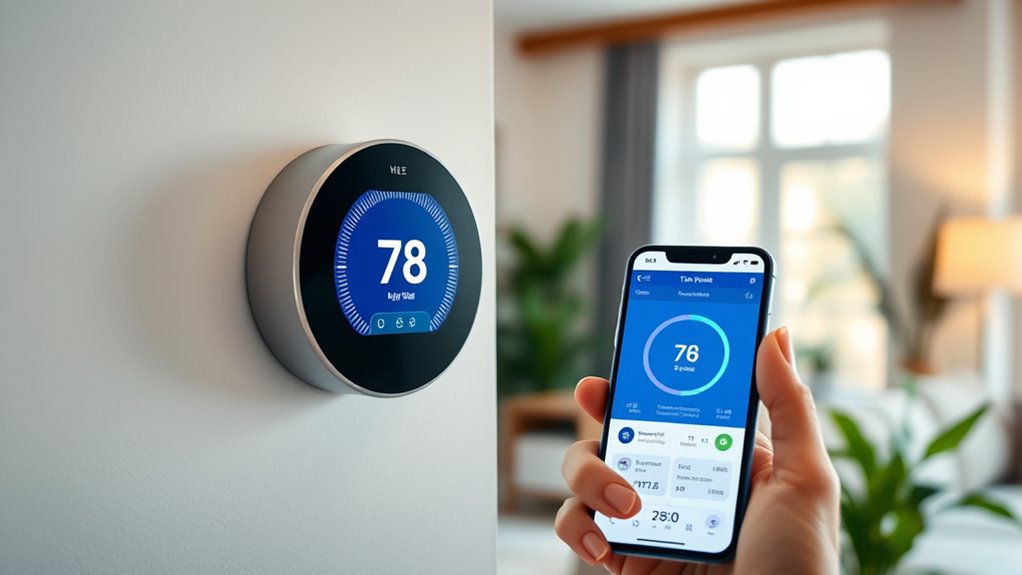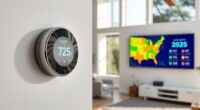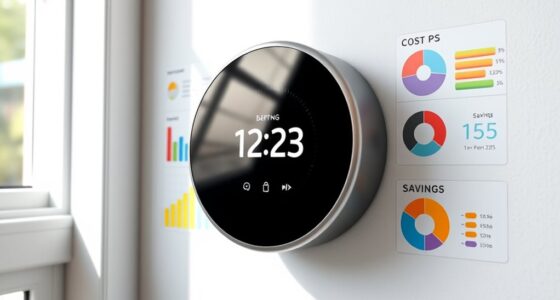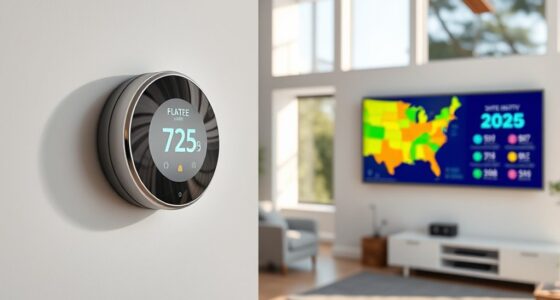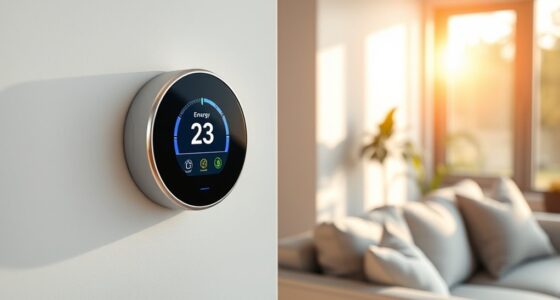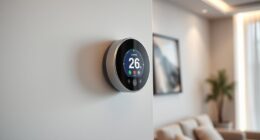Your guide to smart thermostat energy reports helps you understand how they monitor your home’s temperature, humidity, and occupancy to give clear insights into your energy use. You can access these reports easily through your app or device interface, where they display key metrics like energy consumption patterns and cost savings. By recognizing high-usage periods and adjusting your settings, you save money and boost efficiency. Keep exploring to learn how to optimize your energy habits even further.
Key Takeaways
- Understand what smart thermostat energy reports are and how they provide clear insights via user-friendly interfaces.
- Access and interpret reports through apps or devices, focusing on visual data and key summaries for effective analysis.
- Monitor key metrics like energy usage trends, seasonal patterns, and cost savings to identify waste and optimize settings.
- Recognize usage patterns to adjust temperature and humidity settings, reducing waste and enhancing comfort.
- Use report insights to optimize scheduling, troubleshoot issues, and make data-driven adjustments for maximum energy efficiency.
What Are Smart Thermostat Energy Reports?
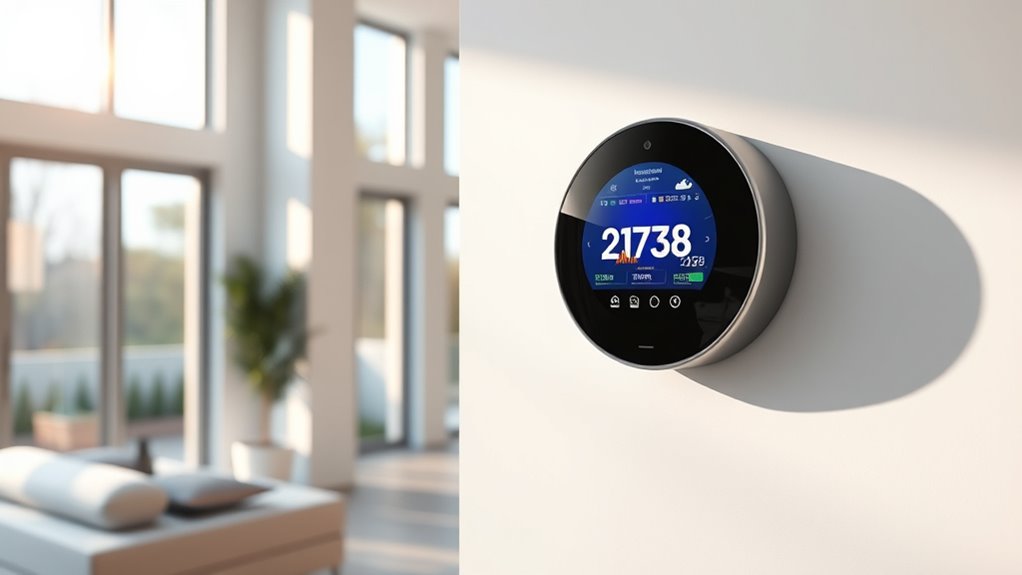
Have you ever wondered how your smart thermostat helps you save energy? It achieves this through smart energy reports that analyze your usage patterns. These reports are generated by hardware integration, connecting sensors and devices to monitor temperature, humidity, and occupancy. These sensors work together to provide accurate data, which enhances the reliability of the reports. The user interface makes accessing these reports simple—you can view detailed data right on your device’s screen or app. Smart thermostats compile this information into clear, easy-to-understand summaries, highlighting when you’re using the most energy. By reviewing these reports regularly, you can identify habits or times of day where you might be wasting energy. This insight enables you to make adjustments, optimize your settings, and ultimately save on energy costs while maintaining comfort. Additionally, understanding energy consumption trends can help you implement targeted strategies for further efficiency.
How to Access and Read Your Energy Reports

To access and read your energy reports, start by opening your smart thermostat’s app or interface on your device. The user interface is designed to be straightforward, allowing you to navigate easily to the reports section. Once there, you can view detailed insights about your energy usage, often presented with graphs and summaries. Keep in mind that your data privacy is protected; reputable systems encrypt your information to prevent unauthorized access. When reviewing your reports, focus on the visual representations and key data points to identify trends and patterns. If needed, adjust your settings or schedule within the app to improve efficiency. Regularly checking your energy reports helps you make informed decisions, saving energy and reducing costs while ensuring your data remains secure. Additionally, understanding energy report features can help you better interpret the data provided, including how energy consumption patterns are displayed and analyzed. Recognizing your energy savings opportunities enables you to further optimize your usage and enhance your home’s overall efficiency.
Key Metrics and Data Points to Watch

When reviewing your energy reports, focus on your consumption trends to identify patterns over time. Keep an eye on cost savings indicators to see how your adjustments are paying off. Tracking these key metrics helps you make smarter decisions to optimize your energy use and save money. Additionally, understanding air quality considerations can guide you in making more informed choices about your thermostat settings and related home appliances. Monitoring juice cleansing trends can also provide insights into how lifestyle habits impact your overall efficiency and wellness. Recognizing home energy audit results can highlight specific areas for improvement, leading to more targeted energy-saving efforts.
Energy Consumption Trends
Monitoring energy consumption trends is essential for maximizing your smart thermostat’s efficiency. By analyzing these trends, you can identify when your smart home uses the most energy for climate control and adjust accordingly. Look for patterns such as increased usage during specific times or seasons, which can indicate opportunities to optimize settings. Tracking key data points like daily or weekly energy use helps you understand how different temperatures or schedules impact overall consumption. Recognizing these trends enables you to make smarter decisions about adjusting your thermostat, reducing unnecessary energy use, and maintaining comfort. Staying on top of your energy consumption trends ensures your smart thermostat works effectively, saving you money while keeping your home comfortable year-round. Incorporating energy-efficient practices based on these insights can further enhance your home’s overall energy management. Additionally, understanding water usage patterns can be beneficial for homes with pools or water features, further optimizing overall home efficiency. Being aware of how energy consumption trends fluctuate can also help you identify potential issues like equipment inefficiencies or unexpected surges in usage.
Cost Savings Indicators
Keeping an eye on key metrics can directly reveal how much money you’re saving with your smart thermostat. Focus on cost reduction indicators like your energy bill analysis to identify patterns and savings. Look for decreases in your monthly bills compared to previous periods, which show your thermostat’s efficiency in reducing unnecessary heating or cooling. Tracking the overall energy consumption trend helps you see if your adjustments are effective. Additionally, compare your current bills with baseline data to measure the impact of specific changes, such as adjusting temperature schedules or optimizing occupancy settings. Monitoring energy efficiency metrics provides clear insights into your savings, allowing you to fine-tune your system for maximum cost reduction. Regularly monitoring these indicators ensures you’re getting the most out of your smart thermostat’s energy reports. For a comprehensive understanding, consider evaluating your projector contrast ratio to better interpret how visual adjustments can optimize your viewing experience and potentially reduce energy use associated with display settings. Additionally, understanding emotional regulation can help in maintaining consistent energy-saving habits, as emotional stability influences decision-making and behavior.
Tips for Using Energy Reports to Save Money
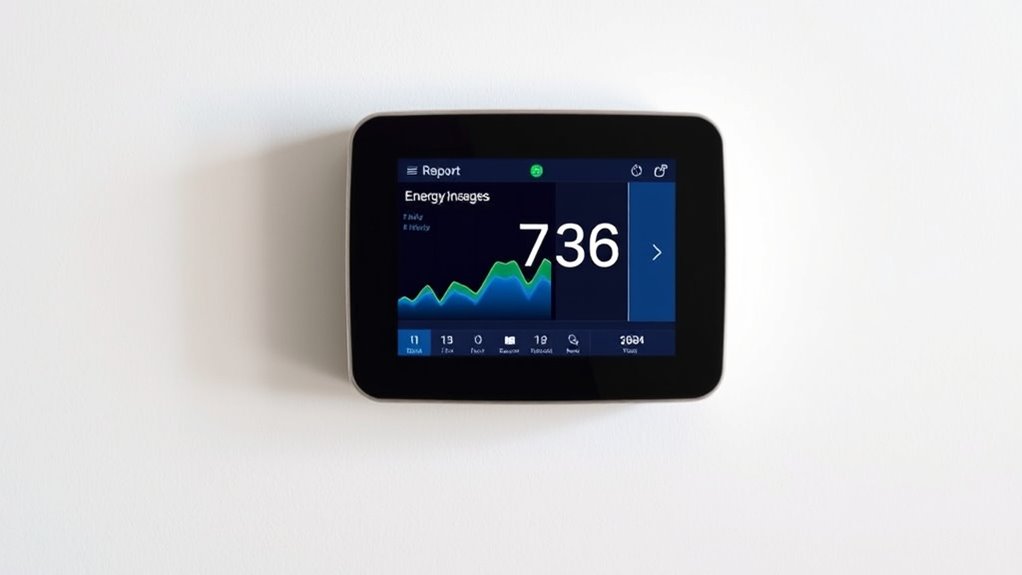
Start by analyzing your usage patterns to identify times when your energy use spikes. Then, adjust your temperature settings and schedule your smart thermostat to optimize efficiency. Incorporating energy reports into your routine can further enhance your savings by providing detailed insights into your consumption habits. Recognizing low battery indicators can also help maintain your device’s performance and ensure accurate data collection.
Analyze Usage Patterns
Ever wonder how your energy reports can reveal patterns that help you save money? By analyzing your usage patterns, you can identify times when your heating or cooling is most active. Look for trends like frequent adjustments or high energy consumption during specific hours. This insight helps you optimize humidity control, which can improve comfort and efficiency. Check if your device compatibility allows you to set schedules that reduce unnecessary operation. Noticing that your system runs excessively during certain periods indicates potential for adjustments. Use this information to fine-tune your thermostat’s settings or consider automating routines. Recognizing these patterns empowers you to make smarter choices, reducing waste and lowering energy bills over time. Additionally, understanding energy consumption patterns can help you implement more sustainable habits that benefit both your wallet and the environment. Incorporating behavioral insights can further enhance your ability to optimize energy use effectively. Being aware of building and utility regulations can also guide you in making compliant and efficient adjustments to your system.
Adjust Temperature Settings
Analyzing your energy reports can reveal opportunities to adjust your thermostat settings for greater savings. If reports show frequent temperature fluctuations or high energy use during certain times, consider setting your thermostat to optimize comfort and efficiency. Adjusting temperature settings based on humidity levels can also improve comfort and reduce energy costs—lowering humidity helps your home feel cooler without lowering the temperature. Regular thermostat maintenance ensures your device functions accurately, preventing unnecessary energy waste. For instance, cleaning or replacing filters and checking calibration can make a big difference. Small tweaks, like raising the temperature slightly in summer or lowering it in winter, can lead to noticeable savings. Incorporating green spaces around your home can help naturally regulate indoor temperatures and reduce reliance on your HVAC system. Smart thermostat features can help automate these adjustments and enhance overall energy efficiency. Use your reports to identify these opportunities and make informed adjustments that keep your home comfortable and energy-efficient.
Schedule Smart Thermostat
Using your energy reports to schedule your smart thermostat effectively can considerably cut your heating and cooling costs. Start by analyzing your reports to identify when your home is unoccupied or needs less temperature regulation. Then, set your schedule accordingly, ensuring your thermostat adjusts during these times. Voice commands make it easy to modify schedules on the fly, especially when your routine changes. Take advantage of integration options with smart home systems to automate schedule adjustments based on occupancy or external factors like weather. Regularly review your energy reports to fine-tune your schedule for maximum savings. Proper scheduling prevents unnecessary heating or cooling, helping you save money while maintaining comfort. User control and consistent adjustments based on data insights keep your energy use efficient and cost-effective. Recognizing patterns in your energy reports can also enhance your understanding of angel number soulmates and how they reflect your relationship energy for better harmony. Additionally, understanding the privacy policy associated with your smart thermostat can help you manage your data and privacy preferences effectively.
Common Challenges and How to Overcome Them
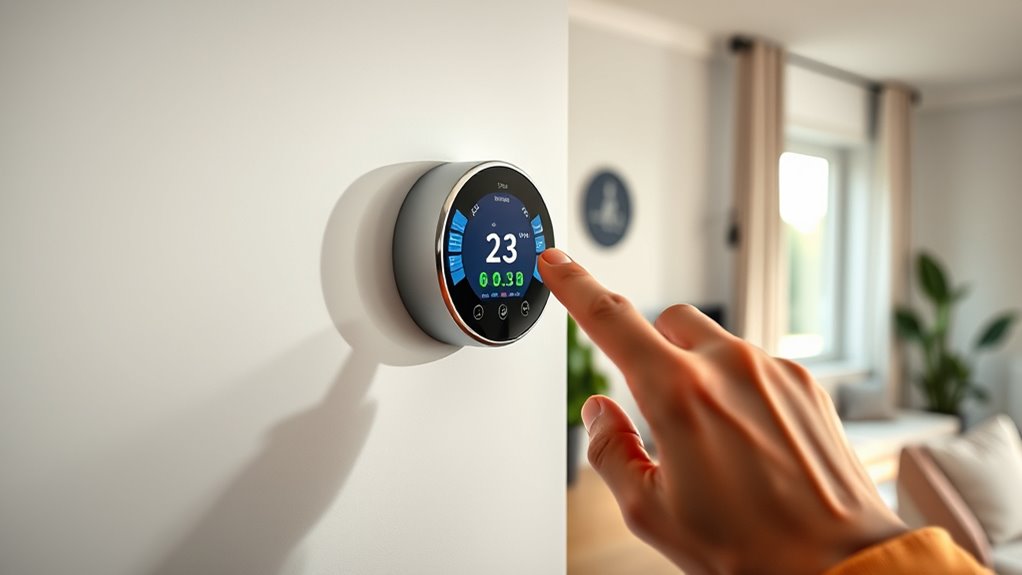
While smart thermostats offer many benefits, users often encounter challenges that can hinder their effectiveness. One common issue is hardware compatibility, as not all devices work seamlessly with every system. To overcome this, check compatibility before purchasing and consult manufacturer guidelines. Data privacy is another concern; since these devices collect sensitive information, ensure your Wi-Fi network is secure and update firmware regularly. Additionally, understanding the specific features of your smart thermostat, such as energy reports, can be improved by exploring user guides and tutorials, which help maximize their utility. You might also face hurdles like:
Check device compatibility and secure your Wi-Fi to maximize smart thermostat effectiveness.
- Difficulty integrating with existing smart home systems
- Limited user understanding of energy reports
- Connectivity issues affecting data accuracy
Addressing these challenges involves researching device specifications, prioritizing security settings, and staying informed about software updates. Tackling these issues guarantees you maximize your smart thermostat’s benefits without frustration.
Making Informed Adjustments for Greater Efficiency
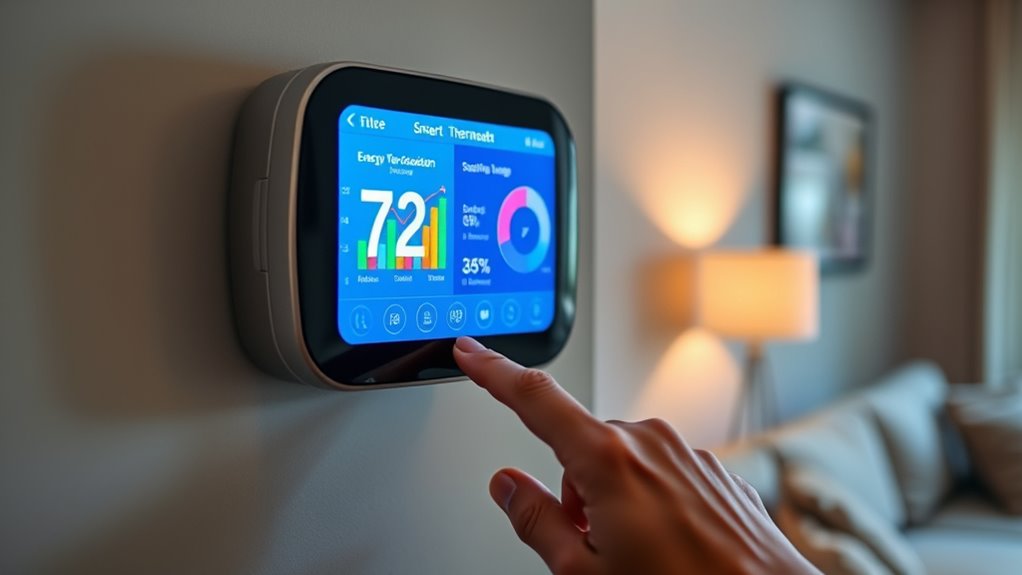
Once you’ve addressed common setup challenges and guaranteed your smart thermostat functions smoothly, the next step is to make informed adjustments that improve your household comfort and energy efficiency. Review your energy reports to identify patterns, such as when your system consumes the most energy. Adjust your schedule or temperature settings accordingly. Confirm your device is compatible with your home’s heating and cooling systems to prevent inefficiencies. For example, use the table below to visualize potential adjustments:
| Current Setting | Suggested Adjustment |
|---|---|
| Night Temperature | Lower by 2°F for savings |
| Day Temperature | Maintain comfort with smart scheduling |
| Equipment Compatibility | Confirm device supports your HVAC system |
Making these tailored adjustments helps optimize performance, saving energy while maintaining comfort.
Frequently Asked Questions
How Often Should I Review My Smart Thermostat Energy Reports?
You should review your energy report frequency regularly to stay on top of your energy use. For most people, checking your smart thermostat energy reports once a month is ideal, as it helps you spot patterns and identify potential savings. However, if you notice unusual energy spikes or changes in your schedule, examine your report more often. Consistent review timing ensures you optimize your thermostat settings and save on energy costs.
Can Energy Reports Identify Specific Appliances Causing High Energy Use?
Energy reports can help you with appliance detection by highlighting patterns in your energy consumption. They don’t always identify specific appliances directly, but they show when your overall energy use spikes. By analyzing these reports, you can pinpoint periods of high consumption and investigate which appliances might be responsible. This insight allows you to make smarter decisions to reduce energy waste and improve your home’s efficiency.
Are There Privacy Concerns With Sharing My Energy Report Data?
Think of your energy report like a diary—sharing it raises data privacy questions. You might worry about third-party access to your usage details, similar to a nosy neighbor peeking over the fence. While many providers implement strong security measures, it’s smart to review privacy policies. You hold the power to control sharing, ensuring your energy data stays private and only accessible to trusted sources.
How Do Weather Changes Affect My Energy Report Readings?
Weather changes, like seasonal fluctuations and temperature variations, can markedly impact your energy report readings. When temperatures drop, your system uses more energy to heat your home, increasing your consumption reports. Conversely, milder weather reduces energy use. You should expect these fluctuations to reflect in your reports, helping you understand how seasonal changes influence your energy efficiency. Keep an eye on these patterns to optimize your thermostat settings accordingly.
Can Energy Reports Help Optimize Multiple Thermostats in Different Zones?
Think of your energy report as a map guiding your home’s comfort. It helps you master zonal optimization, ensuring each zone gets just the right temperature. With this info, you can fine-tune multiple thermostats for multi-zone efficiency, reducing waste and saving energy. By analyzing these reports, you make smarter adjustments, creating a balanced environment that adapts to your lifestyle, all while keeping energy costs in check.
Conclusion
By regularly reviewing your smart thermostat energy reports, you can identify patterns and make smarter adjustments. Did you know that homeowners who actively use these reports save an average of 10-15% on energy bills? Staying informed empowers you to optimize your heating and cooling, reducing costs and environmental impact. So, keep exploring your reports, watch those key metrics, and enjoy the savings — your wallet and the planet will thank you.
